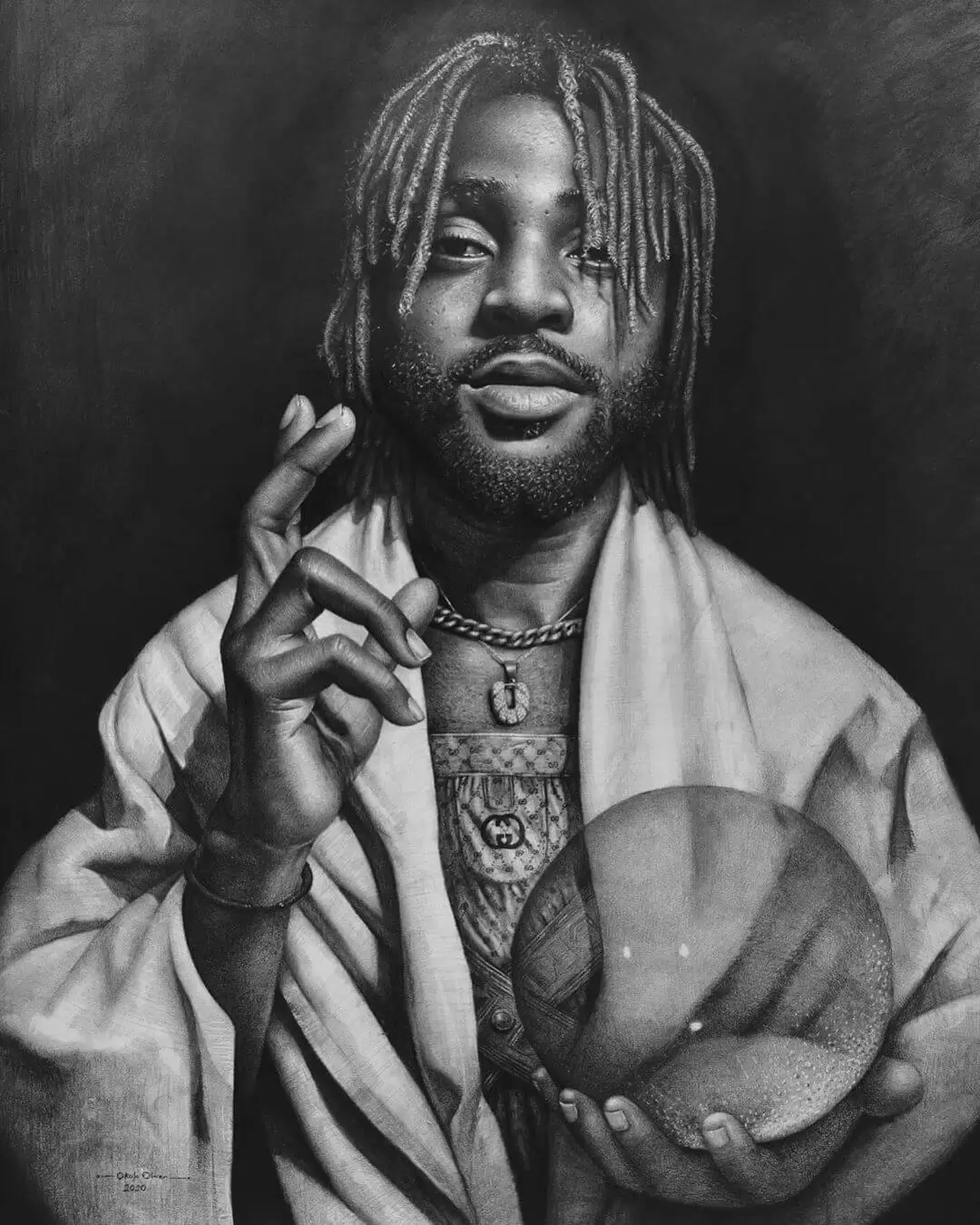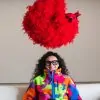Few can master a completed, figurative work using just charcoal. With occasional forays into the usage of photography and oil and acrylic paint, Nigerian artist Okolo Oliver does just that, allowing us to focus on details of a figure while practicing self-awareness.
In every figure drawing there is a story behind it. The forms, values, structures, composition, facial features all come together to convey my message to the world.
Okolo Oliver
The flickers of light that catch on an intricately placed strand of hair, or the pores on a cheek; the downturned eyes of a woman or the fixed look of consternation on a subject’s brow—these details are meant to capture an understanding of both community and self. When looking at works like Rebirth of Mary Magdalene or details of Jesu Christi, it’s hard to believe that the Nigerian artist’s technical abilities are self-taught. His figures are striking and their resonance in the artist’s life add to their dimensionality as subjects. Simply put, they’re not mere muses.

Oliver’s practice flourished as a hyperrealistic style after embarking on independent studies of Old Renaissance and Baroque Masters, at times referencing them in his own work. The Creation of Eve is an allusion to Michelangelo’s depiction of the first woman in The Sistine Chapel ceiling, but it’s a work rarely alluded to, especially in comparison to The Creation of Adam. Instead of a kneeling, Eurocentric Eve, Oliver’s depiction matches Michelangelo’s Adam; Eve’s index finger points to God’s and she takes up the majority of the large-scaled work. Her body is relaxed, unafraid to take up space; celebrated.

Black girl with a pearl earring is—like his work Mary Magadelene and the Vermeer original—a study in light captured in charcoal, with the exception of graphite used in the girl’s sclera, the fibrous “whites” of our eyes. Oliver’s Girl sits more confidently than Vermeer’s; her head is tilted higher, her glance more assured.
It’s no wonder that when Oliver shared the work on his Twitter page in celebration of Black History Month, it quickly became a viral post. Indeed, Oliver’s social media presence is a lesson for all self-taught, burgeoning artists and established students of the craft alike. In this interview, we will learn more about Okolo inspiration, creative process and more.
Q: First thing’s first: why do you do what you do?
A: I do what I do because it the essence of my existence. As a child I have always known I was going to become a creative person. So, growing up I didn’t want to quit drawing. As an adult I realized that art is what gives me the outmost satisfaction I seek and also gives me a voice in my community.
Q: What is your inspiration?
A: I’m greatly inspired by all nature has to offer—most especially human beings. Everything and everyone around me inspires my art. I like to tell stories of the random black people in my community using my expressive figurative portraits.

Q: What is your creative process when you’re creating?
A: My creative process is quite an exciting one for me. I like to take pictures of random people on the streets every day, or even friends and family members. I sketch and do a little thumbnail study of the figure or portrait on my sketchbook just to have a feel and connect with the figure a little more. Then, I cut out a large paper or canvas and start drawing. I ask myself questions a lot while I draw. Like, why the sad look in her/his eyes or why the mild smile. I can never exhaust the possibilities of drawing the human figure; it’s always a different challenge every time, and an exciting one at that.
Q: Which is your preferred surface for working on?
A: I like to work on paper and canvas depending on the texture and effect I want to get. But preferably I work a lot more on paper.
Q: What would you say is an integral part of the work of an artist?
A: Hm… the job of an artist is quite vast. There is a lot of work to do like networking, logistics, managing your studio, keeping invoices, social media management, etc., but I think the most integral part is creating.

Q: What is the reason behind your use of figurativism in your work?
A: I use figurativism in my work because of the stories it has to tell. In every figure drawing there is a story behind it. The forms, values, structures, composition, facial features all come together to convey my message to the world. Depicting reality with figurativism is so amazing.
Q: How do you know when a piece is finished?
A: For me I think a piece of art is never finished. If I ponder on this as an artist I may run mad because as much as I want to put down everything in my head on paper or canvas I can’t do all of that. So, most of my pieces feel finished once I exhaust all possible ways and ideas I want to put into the work, then I abandon the artwork. So, my works are always unfinished even when they look finished.
Q: What is your favourite piece from your collection?
A: I really don’t have a favourite piece of art from my collections; this changes as I create more art, but to answer this question I will say right now my favorite pieces are Jesu Christi and Black girl with a pearl earring.


Q: How did you feel when you did your first solo exhibition?
A: My first solo felt great, although I feels like a blur now, but I can remember the feeling of accomplishment and joy. The name of the exhibition was [titled] Shades, held at The Cube Café and curated by Khenye Gager from Enigma Art Collective. It was an awesome experience.
Q: What is the most rewarding thing for you about being a part of the art industry?
A: Firstly, being able to make some income by creating feels awesome. Secondly, having my works recognized globally makes me feel like I’m a part of a bigger movement. And lastly, the thought of all the bigger things I want to achieve drives me, too.

Is there anything that worries you about how social media is affecting the promotion of artists?
A: Social media has changed a lot of things about art promotion, and I’m trying to move with the trend and push my art out there. It’s a good platform to get your art across to a different, wider audience, aside [from] the old ways of using magazines and tv stations for promoting, which are very picky of what to air or print in their magazines. Social media has given artists the chance to promote themselves whether the art is good or not.
Q: Do you have any advice for artists on how to manage their social media image? Or does it even need managing?
A: Building an online presence is important as an artist in this contemporary era. I will say: being consistent and posting creative photos. And also: keep your page clean.
Q: Do you have any advice for artists starting and don’t know where to begin?
A: I would advise to start from working on your craft and experimenting [with] different mediums and techniques to create. Have an artist mentor—someone [whose work] you enjoy, and follow in their steps. Keep creating.
Q: What would you say is the best way of getting your art noticed in the Age of the Internet?
A: In this age of the Internet I will say the best way to get one’s art noticed is on social media, like Instagram.
Q: Are there any places where you feel Art and Technology really shouldn’t overlap?
A: Honestly, for me I think technology too is art, but also I don’t think technology can take away the power of hand-made art ever.
https://www.instagram.com/okolo_oliver/
©2020 Okolo Oliver




